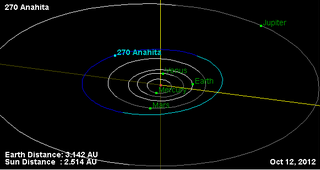
Eukrate is a rather large main-belt asteroid. It is dark and probably a primitive carbonaceous body. The asteroid was discovered by Robert Luther on March 14, 1885, in Düsseldorf. It was named after Eucrate, a Nereid in Greek mythology.

Tirza is a fairly sizeable, very dark Main belt asteroid.

Anahita is a stony S-type Main belt asteroid. It was discovered by C. H. F. Peters on October 8, 1887, in Clinton, New York, and was named after the Avestan divinity Aredvi Sura Anahita.

Fraternitas is a typical Main belt asteroid. It was discovered by Johann Palisa on 6 April 1891 in Vienna. The asteroid name is Latin for 'fraternity'; it was so named in order to commemorate the 25th anniversary of the Maturitätsprüfung Fraternity.

Nassovia is a minor planet orbiting the Sun. It is a member of the Koronis family of asteroids.

Charlotte is a minor planet orbiting the Sun. It was discovered by Paul Götz on September 11, 1904, in Heidelberg.
Kythera is a large, main belt asteroid orbiting the Sun. It was discovered in 1905 by German astronomer M. F. Wolf at Heidelberg, and was named after the Greek island of Kythira that is associated with Aphrodite. The object is a member of the Cybele asteroid group.
Thekla is a minor planet orbiting the Sun. It was named after Saint Thecla of the first century. The name may have been inspired by the asteroid's provisional designation 1906 TC.
616 Elly is a minor planet orbiting the Sun. It is a member of the Maria family of asteroids.
625 Xenia is a minor planet orbiting the Sun. It was discovered by August Kopff in Heidelberg, Germany, on 11 February 1907. The name may have been inspired by the asteroid's provisional designation 1907 XN.
633 Zelima is a minor planet orbiting the Sun in the asteroid belt with a magnitude of 10.7. The name may have been inspired by the asteroid's provisional designation 1907 ZM.
635 Vundtia is a minor planet orbiting the Sun - though this claim has been disputed.
649 Josefa is a minor planet, specifically an asteroid, orbiting primarily in the asteroid belt. Photometric observations provide a rotation period of 10.481±0.001 h with a brightness variation of 0.33±0.04 in magnitude.
663 Gerlinde is a minor planet orbiting the Sun.
738 Alagasta is a main belt asteroid. It was discovered from Heidelberg on 7 January 1913 by German astronomer Franz Kaiser. The asteroid was named in honor of Gau-Algesheim, previously Alaghastesheim, which is the home city of the discoverer's family. This body is orbiting at a distance of 3.04 AU with a period of 5.29 years and an eccentricity of 0.055. The orbital plane is inclined at an angle of 3.53° to the plane of the ecliptic.
768 Struveana is a minor planet orbiting the Sun. The asteroid was named jointly in honor of Baltic German astronomers Friedrich Georg Wilhelm von Struve, Otto Wilhelm von Struve and Karl Hermann Struve.
6144 Kondojiro (1994 EQ3) is an asteroid discovered on March 14, 1994 by Kin Endate and Kazuro Watanabe at the Kitami Observatory in eastern Hokkaidō, Japan. It is named after Jiro Kondo, a Japanese Egyptologist and professor of archaeology at Waseda University.
2011 FW62, also designated 2015 AJ281, is a magnitude-5.0 trans-Neptunian object that was discovered in 2011. Its orbital elements were very uncertain and it was lost. It was recovered on 6 January 2015 as 2015 AJ281. 2011 FW62 has been identified as a member of the Haumea family in a dynamical study led by Proudfoot and Ragozzine in 2019.
(78799) 2002 XW93, provisional designation 2002 XW93, is a trans-Neptunian object and centaur from the outer Solar System, approximately 500–600 kilometers (300–400 mi) in diameter. It was discovered on 10 December 2002, by astronomers at the Palomar Observatory in California.
2021 LL37 is a large trans-Neptunian object in the scattered disc, around 600 kilometres (370 miles) in diameter. It was discovered on 12 June 2021, by American astronomers Scott Sheppard and Chad Trujillo using Cerro Tololo Inter-American Observatory's Dark Energy Camera in Chile, and announced on 31 May 2022. It was 73.9 astronomical units from the Sun when it was discovered, making it one of the most distant known Solar System objects from the Sun as of May 2022. It has been identified in precovery images from as far back as 28 April 2014.






